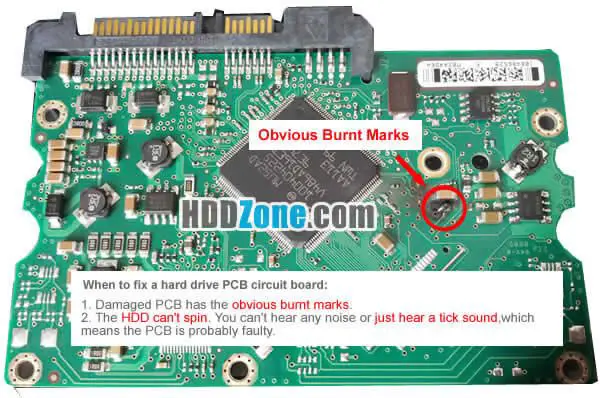A failing or bad hard drive circuit board can cause a variety of issues with your hard drive and computer. The circuit board controls the function and operation of the mechanical parts of the hard drive. If it becomes damaged or fails, it can make your hard drive inaccessible or unable to be recognized by your computer.
Symptoms of a Bad Hard Drive Circuit Board
There are several symptoms that can indicate problems with your hard drive’s circuit board:
- The hard drive is not detected by the computer BIOS
- The hard drive is not showing up in your operating system (e.g. Windows Explorer)
- Your computer displays a message that the drive is not recognized or responding
- You hear beeping or other abnormal noises coming from the hard drive
- The drive spins up but then stops or fails to fully initialize
- You experience freezing, crashing, or difficulty booting your computer
- There are invalid or corrupted drive errors present
- The drive reports input/output errors or other hardware problems
- Bad sectors, data loss, or file system corruption is occurring
Any of these symptoms can indicate potential problems with either the circuit board itself or the hard drive components it controls. The circuit board manages the electromechanical aspects of the drive, so if it is damaged, it can no longer send the right signals to spin up the platters, move the read/write heads, or control data access.
How Circuit Board Damage Occurs
There are several reasons why a hard drive’s circuit board may become faulty or malfunction:
- Physical damage: Dropping a drive, getting moisture inside it, or other physical trauma can damage the delicate components on the circuit board.
- Power surge: Electrical spikes or inconsistencies can overload the circuitry and render it inoperable.
- Overheating: Excessive drive heat causes expansion and contraction that can break solder points or connections.
- Old age: Circuit boards degrade over time, with years of use leading to breakdown of components.
- Manufacturing defects: Imperfections in materials or construction can make a board prone to premature failure.
The location of the circuit board makes it vulnerable – it sits on the exterior underside of the hard drive and is exposed to physical impacts. Even a minor bump can jolt components loose or crack soldered connections between components on the board.
How to Test a Hard Drive Circuit Board
If you suspect your circuit board is causing hard drive problems, there are some steps you can take to test it:
- Check all connectors: Ensure the interface connectors are not damaged or loose. Reseat cables firmly.
- Swap boards: If you have an identical drive, exchange boards to see if the problem follows the board.
- Try an external enclosure: Install the drive in an external dock or USB enclosure to isolate it from other system components.
- Get a diagnostic: Use the drive manufacturer’s utilities to test functionality or run diagnostics like SeaTools.
- Visually inspect: Look closely for burnt, cracked, or broken components on the circuit board.
This can help determine if the circuit board itself is faulty or if the problem lies elsewhere. If problems persist after circuit board replacement, it is likely there is an issue with the drive’s internal hardware components or firmware instead.
Replacing a Bad Hard Drive Circuit Board
If testing confirms the circuit board is defective, replacement provides the best solution. There are two options for replacing a bad drive circuit board:
Buy a Replacement
You can purchase a replacement circuit board identical to your original one. However, finding an exact parts match through the manufacturer or third-party part suppliers can be difficult or expensive. Make sure to match the replacement board’s model number, serial number, firmware revision, and hardware specs exactly.
Repair Using Original Board
In some cases, you may be able to repair the circuit board from your original hard drive rather than replacing it. Options include:
- Reflow solder joints to restore cracked connections
- Bypass damaged control ICs by soldering wires directly between components
- Replace individual ICs or other components using microsoldering
- Clean corrosion from board traces or connectors
This type of circuit board repair requires advanced soldering skills and electronics experience. The complexity makes most DIY repairs impractical, so professional data recovery firms are best equipped for this type of restoration work.
Preventing Circuit Board Failure
You can take some proactive steps to extend the life of your hard drive’s circuit board and electronics:
- Avoid physical shocks/impacts to the drive
- Maintain a steady, cool operating temperature in your computer
- Use a filtered UPS to regulate power and prevent surges
- Periodically backup your data to limit losses in a failure
- Consider replacing older drives after 3-5 years of use
While no drive lasts forever, paying close attention to drive health monitoring and careful handling can help your circuit board avoid premature failure.
Conclusion
A damaged or malfunctioning circuit board is one potential cause of hard drive failure. Symptoms like drive not detected errors, beeping noises, or data corruption indicate the board could be faulty. Testing the board through swapping, external connections, or visual inspection can confirm the problem. Replacement or repair by soldering components offers a fix for the failed circuit board. Following best practices for drive handling, temperature, and power regulation can extend the circuit board’s lifespan.
